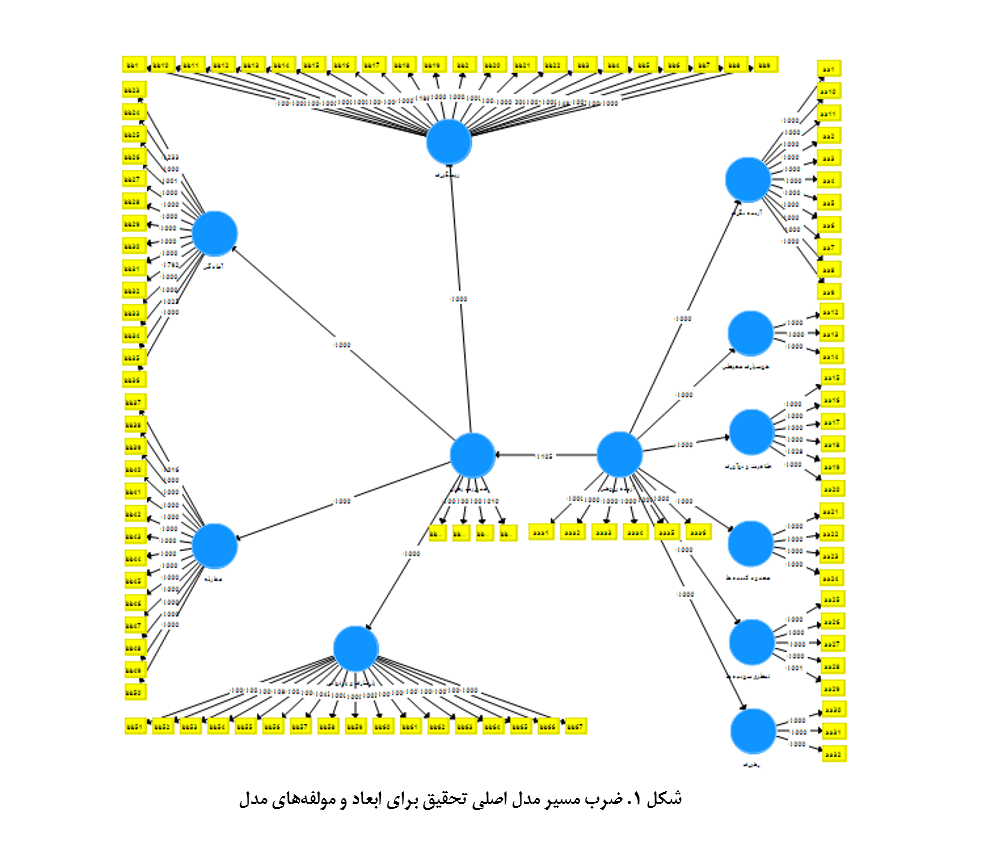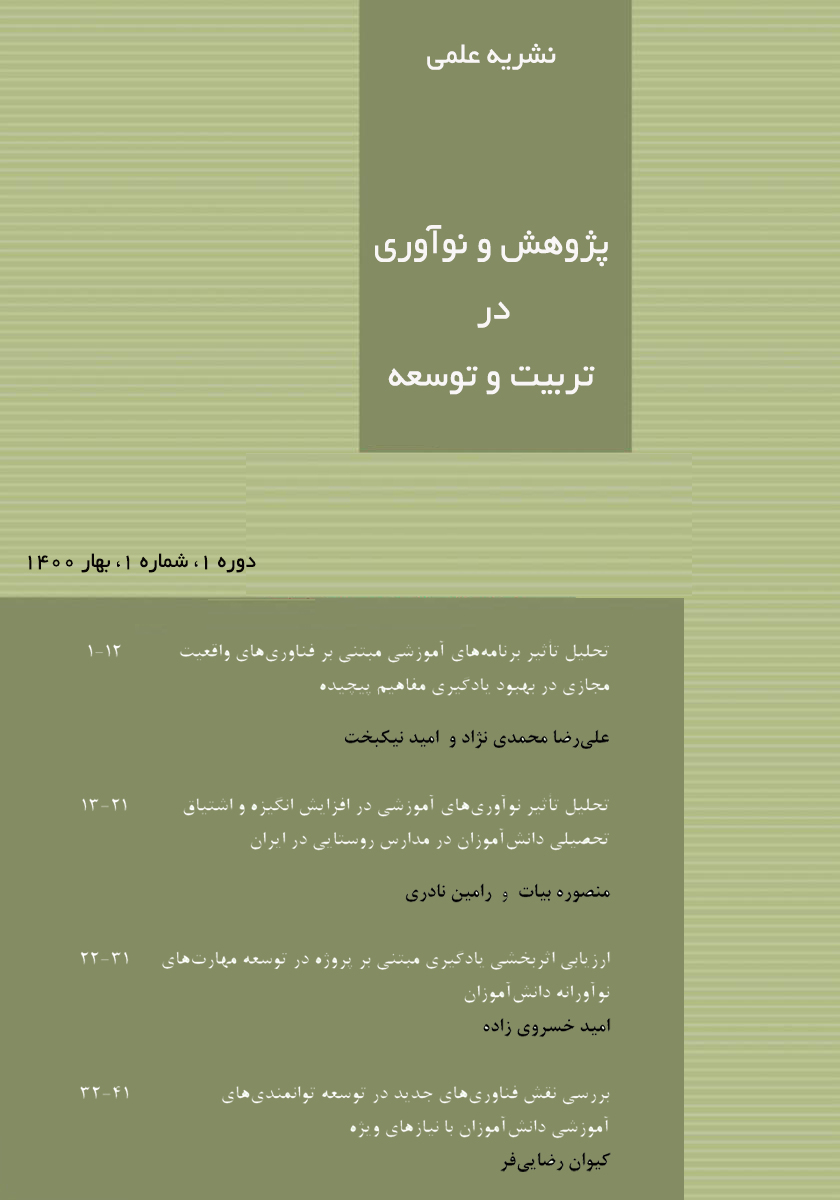شناسایی ابعاد و مولفههای مدل نهادینه کردن آیندهپژوهی در نظام آموزش وپرورش با محوریت مدیریت بحران (مورد مطالعه: آموزش و پرورش شهرستان مشهد)
کلمات کلیدی:
آینده پژوهی, مدیریت بحران, آموزش و پرورش, شهرستان مشهدچکیده
آیندهپژوهی در پی آن است تا با بهرهگیری از تحلیل وضعیت موجود، شناسایی سازوکارهای تغییر و تعریف سناریوهای مختلف، توسعه و بهبود را در آیندههای محتمل و ممکن پیش بینی کند. وجود مدیریت بحران نقش بسزائی در کنترل شرایط و پیش رو شدن با بحرانها در آموزش و پرورش ایفا مینماید. لذا این پژوهش با هدف طراحی مدل آینده پژوهی با محوریت مدیریت بحران در آموزش و پرورش انجام شده است. روش پژوهش، کیفی-کمی (آمیخته) با تاکید بر معادلات ساختاری بود. جامعه آماری را در بخش کیفی 29 نفر از متخصصین و خبرگان که از روش نمونه گیری هدفمند(گلوله برفی) و در بخش کمی شامل کلیه کارکنان آموزش و پرورش شهر مشهد (15000 نفر) بودند، که با استفاده از فرمول کوکران تعداد 450 نفر، با استفاده به روش طبقهای متناسب گزینش صورت گرفت. ابزار تحقیق پرسشنامه محقق ساخته بود که ضریب آلفای کرونباخ آنها 996/0 به دست آمد و روایی صوری و محتوایی آنها با استفاده از نظر خبرگان تایید شد. تجزیه و تحلیل دادهها به کمک دو نرمافزار SPSS و PLS صورت پذیرفت. از بین ابعاد آینده پژوهی، بعد رهبری، خلاقیت و نوآوری، هوشیاری محیطی دارای اهمیت و رتبه بیشتری نسبت به سایر ابعاد (ضریب 0.617،0.660،0.735) و از بین ابعاد متغیر مدیریت بحران به دست آمده بعد مقابله و پیشگیری (ضریب0.753، 0.570) در مدل دارای بیشترین رادر آموزش و پرورش دارا میباشد. مدل مربوطه از برازش مناسب برخوردار بوده و در نهایت تشکیل میز آینده پژوهی با محوریت مدیریت بحران با هدف تعیین راهبردها در کلیه حوزهها و ذینفعان با استفاده از همه ظرفیتهای محلی، ملی، منطقهای و بین المللی برای آینده مطلوب در آموزش و پرورش پیشنهاد میگردد.
دانلودها
مراجع
D'Auria A, De Chiara A, Mauro S, Borrata G. Innovative Self-Management of Knowledge to Thrive Through Crisis:
The Employees' Perspective. Journal of the Knowledge Economy. 2024:1-24. doi: 10.1007/s13132-023-01719-6.
Kazemi SH, Ahmadi E, Mortazavi M. Obstacles and Opportunities for Effective Implementation: A Case Study of
COVID-19 Crisis Policy in Kurdistan Province. dpmk. 2024;13(4):528-45. doi: 10.32598/DMKP.13.4.774.1.
Sharma GD, Kraus S, Liguori E, Bamel UK, Chopra R. Entrepreneurial challenges of COVID-19: Re-thinking
entrepreneurship after the crisis. Journal of Small Business Management. 2024;62(2):824-46. doi:
1080/00472778.2022.2089676.
Basouli M, Jabari G. The Relationship Between Crisis Management and Community Resilience in Tourist
Destinations During the COVID-19 Crisis (Case Study: Hamadan City). 2021.
Durugbo CM, Al-Balushi Z. Supply Chain Management in Times of Crisis: A Systematic Review. Management
Review Quarterly. 2023;73:1179-235. doi: 10.1007/s11301-022-00272-x.
Adams D, Lee KCS, Thien LM, Yusoff NNM. Leading Schools Through the COVID-19 Crisis in a South-East Asian
Country. Management in Education. 2021;38(2):72-8. doi: 10.1177/08920206211037738.
Ahmadi M, editor The Necessity of Innovative Businesses: With a Focus on Crisis Management and Enhancing
Market Competitiveness. International Conference on Management and Accounting; 2016; Tehran: Nikan Higher Education
Institute.
Ray Biswas R, Ray Biswas T, Rahman A. Benchmarking the Effects of Water Demand Management during Water
Crisis in a Regional City. Environmental Management. 2023;72:1277-92. doi: 10.1007/s00267-023-01862-5.
Salehi Khariz Sangi I, Rashidi MM. Knowledge Management and Its Impact on Crisis Mitigation with an Emphasis
on the Agility of Human Resources. Crisis Management Studies. 2023;15(3):131-50.
Rezapour MS, Zamani Y, Esmaeili Beigi HA, Mahani M. Investigating and Comparing the Quality of Educational
Services and Teaching Quality in Educational Centers (Case Study: Islamic Azad University, Payame Noor University, and
Scientific and Applied University of Meybod). Journal of Higher Education. 2018.
Golabchi H, Kiaee M, Kameli MJ. Designing a Superior Service Delivery Model in Education to Enhance Public
Satisfaction. Iranian Journal of Educational Sociology. 2024;7(1):189-97. doi: 10.61838/kman.ijes.7.1.18.
Jahangiri A, heydarbeygi s, Vafayi S. Social responsibility of universities in the face of the Coronavirus crisis
(COVID-19). Quarterly Journal of Research and Planning in Higher Education. 2022;28(3):217-43. doi:
52547/irphe.28.3.217.
Kayes DC, Allen CN, Self N. Integrating learning, leadership, and crisis in management education: Lessons from
army officers in Iraq and Afghanistan. Journal of Management Education. 2013;37(2):180-202. doi:
1177/1052562912456168.
Ahmadian M, Zolfaghari MM, Pour Ezat AA, editors. A Critical and Strategic Analysis of Futurology2017.
Shirvani Naghani M, Ayvazi MR, Ghasemi H. The Nature and Necessity of the Interdisciplinary Concept of Strategic
Futurology in the Field of Futurology. Interdisciplinary Studies in Humanities. 2017;9(3).
Wang J, Hutchins HM. Crisis Management in Higher Education: What Have We Learned From Virginia Tech?
Advances in Developing Human Resources. 2010. doi: 10.1177/1523422310394433.
Najafi R, Khorasani AS, Mohammadi R, Golouy M. Evaluating the Quality of Educational Services Based on the
SERVQUAL Model. Journal of Educational Measurement and Evaluation. 2014:11-27.
Maleki Far A, editor Futurology and Defensive Futurology2007.
Maleki Far A, Fakhraei M, Keyghobadi M. The Alphabet of Futurology: The Science and Art of Discovering the
Future and Shaping the Desired World of Tomorrow: Tehran: Karraneh Elm; 2014.
Mehdi R. Futurology of Higher Education, Strategies and Consequences of University Adaptation to the Environment
and Society. Journal of Management and Development Process. 2015;91:31-54.

دانلود
چاپ شده
ارسال
بازنگری
پذیرش
شماره
نوع مقاله
مجوز
حق نشر 1403 نشریه پژوهش و نوآوری در تربیت و توسعه

این پروژه تحت مجوز بین المللی Creative Commons Attribution-NonCommercial 4.0 می باشد.










